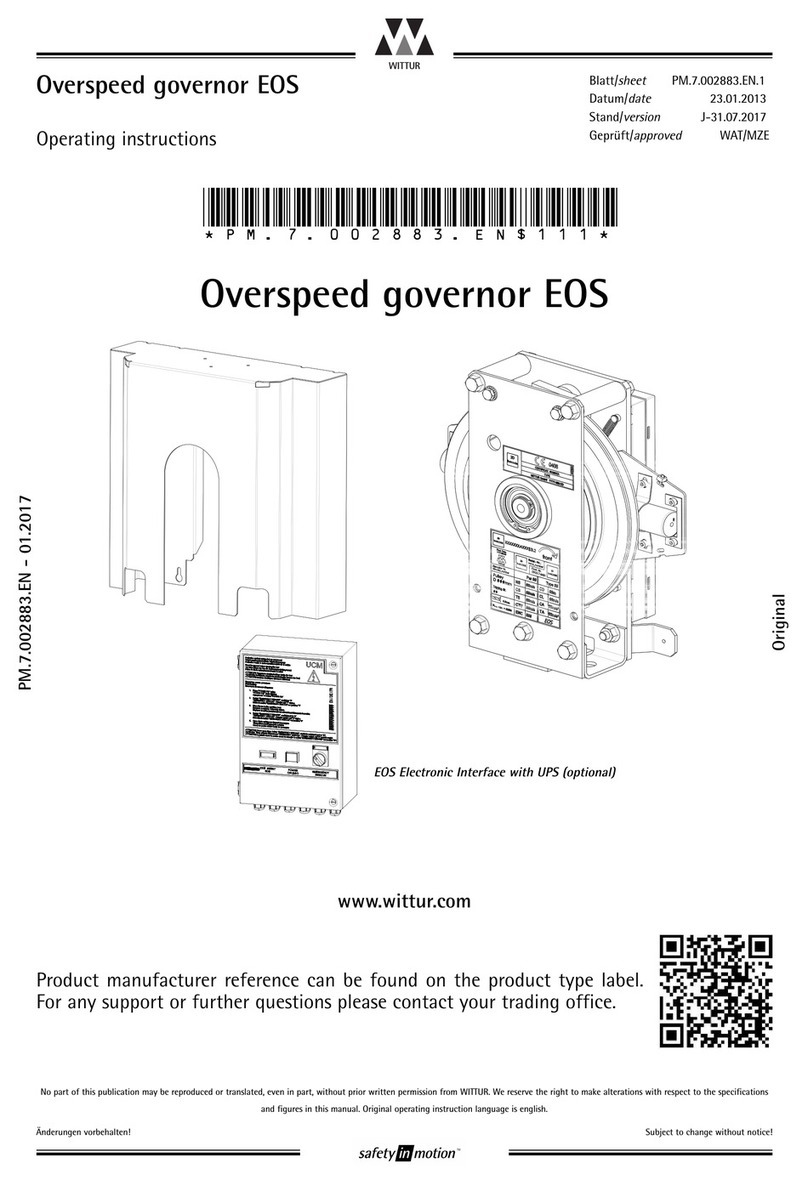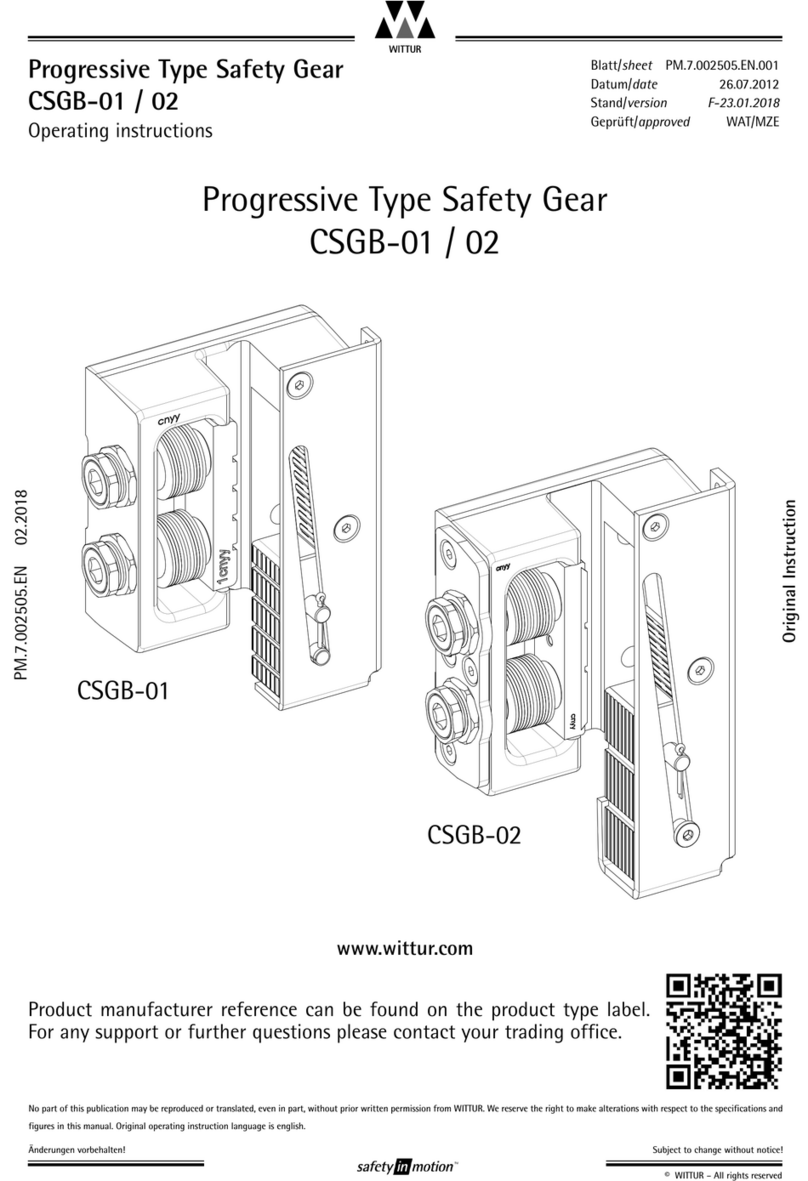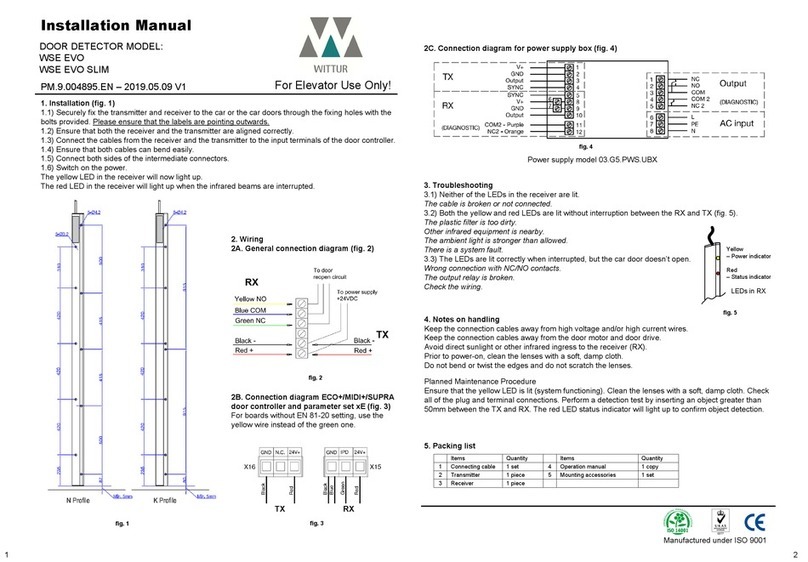Blatt/
sheet
D729MGB.001
Datum/
date
23.05.2007
Stand/
version
G-07.05.2018
Geprüft/
approved
WAT/MZE
Änderungen vorbehalten! Subject to change without notice!
Progressive Safety Gear
USG-25P
Operating Instructions
1 General information prior to installation
1.1 Description and functions . . . . . . . . . . . . . . . . . . . . . . . . . . . . . . . . . . . . . . . . . . . . . . . . . . . . . . . . . .002
1.2 Liability and guarantee . . . . . . . . . . . . . . . . . . . . . . . . . . . . . . . . . . . . . . . . . . . . . . . . . . . . . . . . . . . .003
1.3 Safety precautions . . . . . . . . . . . . . . . . . . . . . . . . . . . . . . . . . . . . . . . . . . . . . . . . . . . . . . . . . . . . . . . .003
1.4 Preparation . . . . . . . . . . . . . . . . . . . . . . . . . . . . . . . . . . . . . . . . . . . . . . . . . . . . . . . . . . . . . . . . . . . . . .004
1.5 Advice for when working on safety components . . . . . . . . . . . . . . . . . . . . . . . . . . . . . . . . . . . . . . .004
1.6 Content of supply . . . . . . . . . . . . . . . . . . . . . . . . . . . . . . . . . . . . . . . . . . . . . . . . . . . . . . . . . . . . . . . .005
2 Name plate, designation, identification
2.1 Labelling according to EN81 (CE) . . . . . . . . . . . . . . . . . . . . . . . . . . . . . . . . . . . . . . . . . . . . . . . . . . . .006
2.2 Labelling according to GOST R 53780 (Russia) . . . . . . . . . . . . . . . . . . . . . . . . . . . . . . . . . . . . . . . . .007
2.3 Range of use . . . . . . . . . . . . . . . . . . . . . . . . . . . . . . . . . . . . . . . . . . . . . . . . . . . . . . . . . . . . . . . . . . . . .008
3 Installation and adjustment
3.1 Mounting to the car frame . . . . . . . . . . . . . . . . . . . . . . . . . . . . . . . . . . . . . . . . . . . . . . . . . . . . . . . . .009
3.1.1 Mounting with lat bars (integrated solution) . . . . . . . . . . . . . . . . . . . . . . . . . . . . . . . . . . .010
3.2 Adjustment of running clearance (gap brake lining to guide rail) . . . . . . . . . . . . . . . . . . . . . . . . .011
3.3 Dimensioning and cut of synchronisation shaft (type A) . . . . . . . . . . . . . . . . . . . . . . . . . . . . . . . .012
3.4 Synchronisation of the safety gear (type A) . . . . . . . . . . . . . . . . . . . . . . . . . . . . . . . . . . . . . . . . . . .013
3.5 Assembling and adjustment of housing (type B) and synchronisation . . . . . . . . . . . . . . . . . . . . .014
3.6 Electrical installation of thesafety gear switch of housing (type B) . . . . . . . . . . . . . . . . . . . . . . .016
3.6.1 Safety gear switch . . . . . . . . . . . . . . . . . . . . . . . . . . . . . . . . . . . . . . . . . . . . . . . . . . . . . . . . . .016
4 Function testing
4.1 irst acceptance test . . . . . . . . . . . . . . . . . . . . . . . . . . . . . . . . . . . . . . . . . . . . . . . . . . . . . . . . . . . . . .017
4.2 Static functions test . . . . . . . . . . . . . . . . . . . . . . . . . . . . . . . . . . . . . . . . . . . . . . . . . . . . . . . . . . . . . . .018
4.3 Dynamic functions test . . . . . . . . . . . . . . . . . . . . . . . . . . . . . . . . . . . . . . . . . . . . . . . . . . . . . . . . . . . .019
4.3.1 Gripping test for car safety gear . . . . . . . . . . . . . . . . . . . . . . . . . . . . . . . . . . . . . . . . . . . . . . .019
4.3.2 Gripping test for counterweight safety gear . . . . . . . . . . . . . . . . . . . . . . . . . . . . . . . . . . . . .020
4.3.3 Checking safety gear, car and counterweight . . . . . . . . . . . . . . . . . . . . . . . . . . . . . . . . . . . .021
4.3.4 Visual checks after a safety gear test . . . . . . . . . . . . . . . . . . . . . . . . . . . . . . . . . . . . . . . . . . .021
4.4 Gripping distance . . . . . . . . . . . . . . . . . . . . . . . . . . . . . . . . . . . . . . . . . . . . . . . . . . . . . . . . . . . . . . . . .022
4.4.1 Determining the gripping distance . . . . . . . . . . . . . . . . . . . . . . . . . . . . . . . . . . . . . . . . . . . . .022
4.4.2 Checkingthe gripping distance . . . . . . . . . . . . . . . . . . . . . . . . . . . . . . . . . . . . . . . . . . . . . . . .022
5 Maintenance, inspection and repair
5.1 Maintenance and inspection . . . . . . . . . . . . . . . . . . . . . . . . . . . . . . . . . . . . . . . . . . . . . . . . . . . . . . . .024
5.1.1 General . . . . . . . . . . . . . . . . . . . . . . . . . . . . . . . . . . . . . . . . . . . . . . . . . . . . . . . . . . . . . . . . . .024
5.1.2 Maintenance and inspection check list . . . . . . . . . . . . . . . . . . . . . . . . . . . . . . . . . . . . . . . . .025
5.1.3 Cleaning of guide rails . . . . . . . . . . . . . . . . . . . . . . . . . . . . . . . . . . . . . . . . . . . . . . . . . . . . . . .025
5.2 Periodical tests . . . . . . . . . . . . . . . . . . . . . . . . . . . . . . . . . . . . . . . . . . . . . . . . . . . . . . . . . . . . . . . . . . .025
5.3 Operational life time of the safety gears . . . . . . . . . . . . . . . . . . . . . . . . . . . . . . . . . . . . . . . . . . . . . .026
5.4 Carrying out repairs . . . . . . . . . . . . . . . . . . . . . . . . . . . . . . . . . . . . . . . . . . . . . . . . . . . . . . . . . . . . . . .026
5.5 Spare parts list (type A) . . . . . . . . . . . . . . . . . . . . . . . . . . . . . . . . . . . . . . . . . . . . . . . . . . . . . . . . . . . .027
5.6 Spare parts list (type B) . . . . . . . . . . . . . . . . . . . . . . . . . . . . . . . . . . . . . . . . . . . . . . . . . . . . . . . . . . . .028
6 Revision Table
Contents Page






























